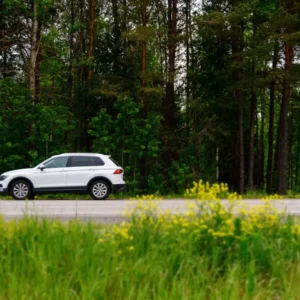Does buying a used car save you a significant portion of your monthly transportation budget? The truth is that, generally speaking, it is not necessarily cheaper to insure a used car than a new one. Much of it depends on the make and model of the particular car, the insurer you choose, and things like your driving record, your age and gender, and the amount you use your car.
Slipping into a brand new car is an unforgettable experience for almost all of us. Still, the choice between buying a new or used vehicle can be a tough one for many. To inform the discussion, we compare insurance rates for new vs. used vehicles.
Example quotes for new and older vehicles
To give you an idea of what premiums you might expect to pay for new and used vehicles, we’ve run sample quotes for the same driver with a brand new car, and then with several older used cars.
| Vehicle | Full Coverage | Basic Coverage | Savings |
|---|---|---|---|
| 2021 Honda CRV EX-L 4DR AWD (Brand New) | $1,956 | $1,475 | 25% |
| 2016 Honda CRV EX-L 4DR AWD (Used) | $1,944 | $1,527 | 21% |
| 2011 Honda CRV EX-L 4DR AWD (Used) | $1,901 | $1,575 | 17% |
| 2006 Honda CRV EX-L 4DR AWD (Used) | $1,941 | $1,639 | 16% |
*Rates provided by Mitch’s car insurance quoter, with access to 40+ insurance companies in Ontario.
Although the quotes and percentages above don’t necessarily reflect what you would see with a different driving record, different address and different vehicle, they do illustrate a general reality of auto insurance in Ontario: While premiums for optional physical damage coverage (collision and comprehensive) do come down with older cars, premiums for mandatory coverages (accident benefits, liability etc.) generally go up.
Will buying a used vehicle save me on my insurance bill?
Those who own older cars do typically pay a little less for car insurance, but this isn’t necessarily because older cars are cheaper to insure. The biggest reason they are paying less is that the vast majority of cars lose value over time, faster in the first few years, and some drivers choose to remove optional coverages on much older cars.
The way insurance works is also different with a new car. Most insurers offer a waiver of depreciation for a car that’s less than 3 (or sometimes 5) years old. Meaning if the vehicle is totaled, you get a brand new car. On the other hand, if a ten-year-old car met the same fate, you would only receive enough to buy a comparable used car, which is likely less than 10% of the original value.
This disparity in potential payouts will be reflected in somewhat lower premiums for physical damage coverage, but as you can see from the table above, the cost of your basic (mandatory) insurance will go up, largely offsetting any savings. If at this point you remove all physical damage coverage, you will save some money, maybe 15-20%, but not nearly what you might expect given the diminished value of the vehicle.
The moral of the story is that your premium is affected mostly by the likelihood of you getting injured in an accident, not so much by the likelihood of having to repair or replace your car.
Should I remove comprehensive and collision if possible?
Based on industry statistics, collision coverage makes up roughly 20% of your premium and comprehensive coverage comprises just under 12%, so you may think that removing these two optional coverages is going to save you over 30% on your insurance bill.
But hold on a second. Your older car probably isn’t worth as much as the average car in Ontario, on which these figures are based. This means you won’t be saving 30% when you remove comprehensive and collision from your policy, as these coverages make up a smaller and smaller percentage of the cost.
The reality is more like this:
- On a 10-year-old car, you might save 17-20%.
- On a 20-year-old car, this would be more like 12-15%.
Accident benefits and third party liability are mandatory coverages in Ontario and make up the lion’s share of full coverage insurance rates. Since these coverages apply more to the people in the vehicle than the vehicle itself, these costs are not related to depreciation, and actually tend to go up with an older car. Premiums for these coverages hinge on the probability of injuries, and older cars are less likely to have the most recent safety advancements.
The cost of parts
Traditionally, insurance providers would sometimes reduce their rates as popular models got older since they would have more options for replacement parts. Whereas new vehicles need to be repaired using the same manufacturer’s (OEM) parts, older vehicles can be repaired with less expensive “aftermarket” parts, or parts not made by the car manufacturer itself.
Also, these days, the newer the car, the more likely it is to be equipped with enhanced safety features like backup cameras, lane departure warning and emergency brake assist, to name a few. Even though these features reduce the probability of a collision, resulting in a general reduction in the number of claims, the cost of each claim is driven up by the fact that many bumpers, windshields and even mirrors now have sensors and cameras that make them much more expensive to repair or replace.
For example, if you had a minor accident in, say, a 2005 Toyota Matrix, you could simply replace the bumper, and 500 bucks later, you’re all good. On the other hand, if you’re driving a more recent model, with all those sensors and cameras built into the mirrors and bumpers and calibrated to a computer that’s basically running your car, even a minor accident in which you merely dent the bumper can end up costing thousands of dollars.
So, as you can see, a lot depends on the specifics of the particular used vehicle you are driving, the availability of replacement parts for that vehicle, and just how “enhanced” it is.

Insuring a classic car
Remember classic and vintage cars are insured in a completely different way than typical used cars. While a regular insurance policy may be a possibility, classic car coverage is most likely the way to go. This kind of coverage usually insures classic cars at a higher value than the list price, and limits mileage.
Does a waiver of depreciation change the equation?
If you are looking to minimize the effect of depreciation in the first 2-5 years of the life of your vehicle, and you want to be sure that you get a brand new replacement vehicle should your car be damaged beyond repair, you will need either GAP insurance or a Waiver of Depreciation.
Waiver of depreciation
- Seller: Bought through your auto insurer
- Cost: $75 extra in the first year, and as little as $300 in the fifth year
- Benefit: if your car is written off, your insurance company will buy you a new, similarly equipped car of the same make and model
GAP Insurance (Guaranteed Asset Protection)
- Seller: Bought through your finance company
- Cost: a lump sum added to your total loan amount – meaning you will pay a slightly higher monthly payment on that loan
- Benefit: if your car is written off, any outstanding debts remaining after your Insurance company pays you the Actual Cash Value (ACV) of your car at the time of the accident are wiped clean
The fact is that both of the above are ways to increase your coverage in the event of a total loss, and both will make insuring your new vehicle somewhat more expensive. Hence, yes, it may change the equation, in that it makes insuring a new vehicle that much more expensive.
Note: A waiver of depreciation is only available to the first owner of the vehicle, while GAP insurance is typically available for any vehicle that is financed, regardless of whether it is new or used.
Can sort it all out for you
Here at Mitch we know that the cost of insurance is a big factor when buying a car. So whether you are thinking of buying a new car, a used car, or even a classic car, be sure to contact a Mitch broker, ideally before you make a decision. We can get you quotes on all the vehicles you are considering, and help you make the decision that is right for you, and your monthly budget!
Looking for car insurance?
Speak with a Mitch Insurance broker today to get a quote on Ontario auto insurance.
Call now
1-800-731-2228







